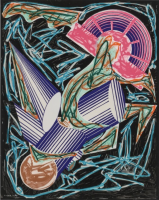
Details
Artist
Styles
A Hungry Cat Ate Up the Goat, Illustrations After El Lissitzky's Had Gadya - lithograph, linocut, and screenprint in colors with hand-coloring and collage, on wove paper, 1984, signed and dated in pencil, numbered PP II, published by Waddington Graphics, London - Sheet: 45 ½ x 53 ½ in. (1158 x 1359 mm.) // A Hungry Cat Ate up the Goat by Frank Stella is a vibrant limited edition print from 1984, part of his series inspired by El Lissitzky's Had Gadya. This mixed media piece combines lithograph, linocut, screen print, hand-coloring, and collage on wove paper, showcasing Stella's dynamic use of color and form. The composition bursts with jagged shapes and layered textures in a swirling pattern of pastel blue, yellow, and pink against bold dark outlines. The work's frenetic energy and fragmented forms evoke a sense of playful chaos, perhaps alluding to the whimsical tale of Had Gadya. Stella’s layering technique enhances the visual depth, inviting viewers to explore each vibrant shape’s role within the complex structure.
A Hungry Cat Ate up the Goat, 1984
form
Medium
Size
116 x 136 cm
- Inches
- Centimeters
Edition
Price
- USD
- EUR
- GBP
Details
Artist
Styles
A Hungry Cat Ate Up the Goat, Illustrations After El Lissitzky's Had Gadya - lithograph, linocut, and screenprint in colors with hand-coloring and collage, on wove paper, 1984, signed and dated in pencil, numbered PP II, published by Waddington Graphics, London - Sheet: 45 ½ x 53 ½ in. (1158 x 1359 mm.) // A Hungry Cat Ate up the Goat by Frank Stella is a vibrant limited edition print from 1984, part of his series inspired by El Lissitzky's Had Gadya. This mixed media piece combines lithograph, linocut, screen print, hand-coloring, and collage on wove paper, showcasing Stella's dynamic use of color and form. The composition bursts with jagged shapes and layered textures in a swirling pattern of pastel blue, yellow, and pink against bold dark outlines. The work's frenetic energy and fragmented forms evoke a sense of playful chaos, perhaps alluding to the whimsical tale of Had Gadya. Stella’s layering technique enhances the visual depth, inviting viewers to explore each vibrant shape’s role within the complex structure.
- Recently Added
- Price (low-high )
- Price (high-low )
- Year (low-high )
- Year (high-low )
Frank Stella
Had Gadya: Front Cover, From Illustrations After El Lissitzky's Had Gadya, 1984
Limited Edition Print
Collage
Inquire For Price
Frank Stella
Honduras Lottery Co (from Multicolored Squares), 1970
Limited Edition Print
Lithograph
USD 9,650
Frank Stella
Gran Cairo (from Multicolored Squares), 1970
Limited Edition Print
Lithograph
USD 7,000
Frank Stella
Turkish Mambo (From Black Series), 1967
Limited Edition Print
Lithograph
Artwork On Hold
Frank Stella
Imola Three, I (from The Circuits Series), 1982
Limited Edition Print
Mixed Media
USD 43,000 - 50,000
Frank Stella
Polar Co-ordinates VIII, From Polar Co-ordinates For Ronnie Peterson, 1980
Limited Edition Print
Mixed Media
Currently Not Available
What is abstract art?
Abstract art uses form, shape, line, and color to create a visual experience without attempting to represent external reality. The composition exists independently of the world's visual references, focusing on expressing ideas and emotions through non-representational means.














































